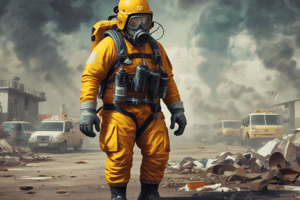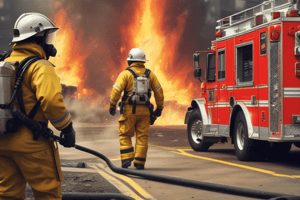Podcast
Questions and Answers
What is the primary goal of a First Responder at the awareness level when approaching a scene with hazardous materials?
What is the primary goal of a First Responder at the awareness level when approaching a scene with hazardous materials?
- To identify the source of the hazardous material
- To immediately evacuate the area
- To provide medical assistance to those involved
- To recognize and respond to the risks posed by the hazardous materials (correct)
What is an indicator of the possible presence of a hazardous material in a facility or business?
What is an indicator of the possible presence of a hazardous material in a facility or business?
- The location and type of building (correct)
- The number of employees
- The presence of security cameras
- The presence of fire alarms
What is the purpose of secondary containment in bulk storage containers?
What is the purpose of secondary containment in bulk storage containers?
- To control spilled or released product (correct)
- To store additional quantities of the chemical
- To prevent the release of hazardous materials
- To monitor the temperature of the chemical
What is the purpose of the marking system used by the Department of Transportation?
What is the purpose of the marking system used by the Department of Transportation?
What is the typical capacity of a carboy?
What is the typical capacity of a carboy?
What is a signal to move to a place of safety when approaching a scene with hazardous materials?
What is a signal to move to a place of safety when approaching a scene with hazardous materials?
What is the primary purpose of the National Fire Protection Association 704 marking system?
What is the primary purpose of the National Fire Protection Association 704 marking system?
What is the primary source of information about a particular chemical in a work environment?
What is the primary source of information about a particular chemical in a work environment?
What is the first step when responding to a hazardous material leak or spill?
What is the first step when responding to a hazardous material leak or spill?
What is the purpose of decontamination in a hazardous material response?
What is the purpose of decontamination in a hazardous material response?
Who makes the decision to transport patients in a hazardous material response?
Who makes the decision to transport patients in a hazardous material response?
What is the purpose of a warm zone in a hazardous material response?
What is the purpose of a warm zone in a hazardous material response?
Flashcards are hidden until you start studying
Study Notes
• A hazardous material is any material that poses an unreasonable risk of damage or injury, and First Responders at the awareness level should be trained to recognize and respond to these risks.
• To recognize the presence of hazardous substances, First Responders should approach the scene from a safe location and direction, use binoculars to view the scene from a safe distance, question anyone involved, and formulate a plan for addressing the incident.
• Chemicals are often stored in facilities or businesses, and the location and type of building can be indicators of the possible presence of a hazardous material.
• The presence of vapor clouds, hazmat placards or labels, or alarm from a toxic gas sensor are signals to move to a place of safety.
• Containers of hazardous materials vary in type, size, and material of construction, but provide important clues about the nature of the substance inside.
• Bulk storage containers are found in buildings that rely on and need to store large quantities of a particular chemical and have secondary containment to control spilled or released product.
• Other types of containers include totes, intermodal tanks, non-bulk storage vessels like drums and bags, and carboys, which are glass, plastic, or steel containers that hold 5-15 gallons of a product.
• The Department of Transportation has a marking system characterized by labels, placards, and markings to give an idea of the hazard inside a particular container.
• The National Fire Protection Association 704 marking system is the standard system for identification of hazards of materials for emergency response and classifies hazardous materials for fixed facilities.
• The system uses a diamond-shaped symbol broken into four smaller color-coded diamonds that indicate health, fire, and reactive hazards.
• Emergency Response Guidebooks (ERG) are available on every ambulance and can be used to reference placards and determine the threat, treatment, and neutralization of a hazardous material.
• Safety Data Sheets (SDS) are a common source of information about a particular chemical and must be present in any work environment.
• Shipping papers are required for transportation of hazardous materials and include the names and addresses of the shipper and receiver.
• The Chemical Transportation Emergency Center (CHEMTREC) is a clearinghouse of technical chemical information that provides information through telephone, fax, or other electronic media.
• When recognizing a hazardous material, it's essential to maintain a high index of suspicion, looking for signs such as visible clouds, strange smoke, leaks, spills, or unusual odors.
• If multiple people have collapsed or are unresponsive, assume a hazardous material leak or spill and take necessary precautions.
• First Responders should avoid contact with the material if possible, call in the HazMat team, and focus on ensuring safety and survival of the greatest number of people.
• Control zones should be established based on the chemical and physical properties of the released material, including hot, warm, and cold zones.
• Decontamination areas should be set up in the warm zone, and personnel must pass through decontamination before entering the cold zone.
• Different levels of protective equipment (PPE) are required for different situations, ranging from Level D (lowest level) to Level A (fully encapsulated chemical-resistant garment).
• Patient assessment and care should follow standard protocols, with a focus on supportive care and initiating transport, and decontamination should be done before applying bandages or splints.
• The goal of decontamination is to cut away the patient's clothing and do a rapid rinse, and powder substances should be brushed off before rinsing.
• The Incident Commander makes the decision to transport patients, and ambulances should be decontaminated before transporting another patient.
Studying That Suits You
Use AI to generate personalized quizzes and flashcards to suit your learning preferences.




